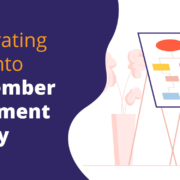Boosting Virtual Member Engagement: The Definitive Guide
Member engagement is a driving force in growing your association. Fonteva’s guide to member engagement defines this term as “the ongoing outreach and interactions between associations and their members to keep constituents informed, educated, and motivated to continue their memberships.” With an engaged membership base, your organization will see increased retention, a stronger community, and even increased non-dues revenue.
When planning for your association’s future, it’s crucial to consider how you will keep current members engaged while attracting new ones. Improving member engagement will require you to explore your association’s strengths and weaknesses as well as your members’ needs and preferences. To get started, you’ll need to employ the following strategies:
- Set goals and choose engagement strategies.
- Understand and appeal to members.
- Prioritize community building.
In this guide, we’ll break down each of these tactics and how they will put you on the path toward deeper virtual engagement. Let’s get started!
1. Set goals and choose engagement metrics.
Outlining the goals you’d like to achieve must be the first step you take toward increased engagement. The goals your organization chooses will dictate which initiatives you focus on, how resources are allocated, and which metrics you’ll need to track in order to measure success.
To get started, look at your association’s past performance. You might reference member surveys to understand what areas could use improvement, developing goals meant to target those weaknesses. The goals you create should be structured as “SMART” goals, or goals that are specific, measurable, achievable, relevant, and time-bound.
Let’s say you want to boost your association’s social media presence. One of your goals could be to increase your LinkedIn follower count from 500 to 1,000 within the next year. Because this goal uses a specific number and timeframe, is realistic, and is relevant to your objective, it qualifies as a SMART goal.
Once you’ve settled on a few engagement goals for your association, it’s important to start tracking metrics related to those goals so you can accurately measure your progress. Here are some common key performance indicators (KPIs) that can help you track improvements in virtual member engagement:
- Social media metrics: Social media provides a treasure trove of useful data about users and how they interact with your page. You can track your follower count, likes, comments, shares, click-through rates, and more (depending on your goals). To narrow down which metrics you’ll track, remind yourself of your goals and develop KPIs that directly apply to those goals.
- Virtual event KPIs: If your association holds virtual or hybrid events, make sure to measure the engagement of virtual attendees (just like you would for in-person attendees). You can measure factors like registrations, actual attendance, returning and new attendees, and participation time.
- Email marketing engagement: Emails likely play a big role in how your association attracts new members and connects with existing ones to keep them in the loop. You can track how engaged members are in your announcements, newsletters, fundraising prompts, or other campaigns by measuring metrics like open rates, click-throughs, conversions, and unsubscribes.
Many of these metrics can be tracked using an association management tool to create custom reports to visualize your organization’s performance. These reports provide a much more accurate, easy-to-understand way to analyze association data.
2. Understand and appeal to members.
After deciding on your association’s core engagement goals and identifying how you’ll measure progress, you’ll need to start implementing strategies that improve engagement opportunities for members.
If your organization is seeing low engagement rates across the board, your current offerings may not align with what members are looking for. To make the switch to discussing topics and holding events your members will be excited about, you’ll need to learn more about their interests.
Here are some of the strategies you can use to understand your members and adjust association activities to meet their needs:
- Send out surveys. Surveys are a great way to see inside your members’ minds and hear directly from them what they expect from your organization. There are many kinds of surveys you can send, depending on what you want to learn from members. You might send more general surveys asking about their interests, or narrow the subject by asking how your virtual engagement strategies could be better. Another popular way to get member feedback is by sending post-event surveys (ideally, there should be separate surveys for in-person and virtual attendees).
- Segment members. Create groups of members based on shared characteristics like their interests, tendencies, or preferences. For example, you might create a subset of members who take advantage of almost all of your continued learning opportunities and further segment these members by their communication preferences. Then, you can direct communications about the opportunities and subjects they are interested in to those segments as appropriate.
- Set up a variety of engagement opportunities. Because your members each have different preferences and goals, make sure to offer various engagement opportunities to address their unique needs. Options for virtual engagement can include virtual events, meetings, learning opportunities, and discussion forums, all providing a different way to connect and build a community. For instance, members who want to expand their network and form relationships outside of association events and meetings may use your membership directory most often.
Taking an approach that focuses primarily on meeting individuals’ needs rather than creating a blanket solution will make all members feel included and catered to. Over time, this careful consideration will help build more positive member experiences.
3. Prioritize community building.
Additional engagement opportunities like fun events or fundraisers can help add value to the membership. These activities strengthen the bonds between members in your community, leading to increased renewals and member retention rates. While you may think of these events as being limited to in-person annual dinners, there are virtual and hybrid options you can extend to remote members as well (like a quarterly virtual happy hour).
Fundraisers are a great way to unite your members for a common cause, whether you are fundraising for your association or on behalf of a charitable organization. To get members more engaged in the fundraising process, you can put together a member-led fundraising committee. Give this committee specific responsibilities like developing fundraising ideas, planning fundraisers, and executing fundraising events.
After your event or fundraiser wraps up, always remember to thank those who attended or donated. These thank yous will keep members coming back to your events or donating in the future. Keep in mind that the time period following a successful event or fundraiser can be a good opportunity to send renewal reminders, if applicable.
Virtual member engagement goes beyond encouraging connections between individual members and your association. It also motivates members to connect with one another, building a web of professional relationships that they can leverage to advance their careers, further their education, and secure exciting new opportunities. To achieve this level of engagement and give members the experiences they are looking for, be sure to select a membership management platform that will make implementing new strategies and measuring your progress simple.





